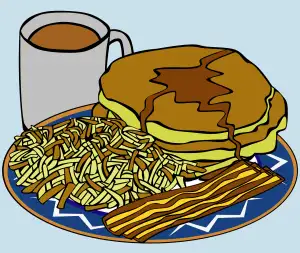Pure Delight: Unveiling the Art of Plain Scones - A Perfectly Simple Indulgence

- History and origin of plain scones
- Ingredients required to make plain scones
- Step-by-step instructions for making plain scones
- Tips and tricks for achieving the perfect plain scones
- Serving suggestions and accompaniments for plain scones
- Variations and adaptations of plain scones
- Health benefits of plain scones
Plain scones, a beloved British classic, are a delightful treat that embody simplicity and elegance. With their light and fluffy texture, these baked goods are the perfect canvas for a variety of toppings and accompaniments. Whether enjoyed at breakfast, afternoon tea, or as a sweet snack, plain scones offer a moment of pure indulgence. In this article, we will delve into the art of making plain scones from scratch and explore the many ways they can be enjoyed. Get ready to embark on a journey of taste and discover the pleasure of this perfectly simple delight.
History and origin of plain scones
The history of plain scones can be traced back to the British Isles, where they have been enjoyed for centuries. The exact origin of scones is unclear, but they are believed to have originated in Scotland or Ireland. Originally, scones were made with oats and cooked on a griddle. Over time, the recipe evolved and wheat flour became the main ingredient. Scones gained popularity in England during the 18th century and quickly became a staple of afternoon tea. Today, plain scones are beloved worldwide for their simplicity and delicious taste.
Ingredients required to make plain scones
To create the perfect plain scones, you will need just a handful of simple ingredients. The foundation of any good scone recipe starts with flour, preferably all-purpose or self-rising for a light and fluffy texture. You will also need baking powder to help the scones rise and achieve that desired flakiness. To add richness and tenderness, butter is essential. Make sure it's cold and cut into small cubes before incorporating it into the dough. Sugar is another key ingredient, providing a touch of sweetness to balance out the flavors. Lastly, don't forget about milk or buttermilk to bring everything together and create a moist dough. With these basic ingredients in your pantry, you'll be well on your way to creating delectable plain scones that are sure to please any palate.
Step-by-step instructions for making plain scones
1. Preheat the oven to 220°C (425°F) and line a baking tray with parchment paper.
2. In a large mixing bowl, combine 2 cups of all-purpose flour, 2 tablespoons of sugar, 1 tablespoon of baking powder, and a pinch of salt.
3. Cut in 6 tablespoons of cold unsalted butter using a pastry cutter or your fingertips until the mixture resembles coarse crumbs.
4. Make a well in the center and pour in 1/2 cup of cold milk. Stir gently until just combined; do not overmix.
5. Turn the dough out onto a lightly floured surface and knead it gently a few times to bring it together.
6. Roll out the dough to about 1-inch thickness and use a round cookie cutter to cut out scones.
7. Place the scones on the prepared baking tray, leaving some space between them for expansion.
8. Brush the tops with milk or beaten egg for a golden crust.
9. Bake for 12-15 minutes or until the scones are lightly golden on top and cooked through.
10. Remove from the oven and let them cool on a wire rack before serving.
Enjoy these warm, fluffy plain scones with your favorite jam and clotted cream for an indulgent treat!
Tips and tricks for achieving the perfect plain scones
To achieve the perfect plain scones, follow these tips and tricks:
1. Keep your ingredients cold: Cold butter and milk help create a flaky texture. Chill them before use.
2. Don't overmix: Overmixing can result in tough scones. Mix until just combined for a tender crumb.
3. Use a light touch: Handle the dough gently to avoid compacting it. This will ensure a light and airy texture.
4. Shape with care: Pat the dough into a round shape, then cut into individual scones using a sharp cutter without twisting.
5. Brush with egg wash: Before baking, brush the tops of the scones with an egg wash for a golden crust.
6. Bake at the right temperature: Preheat your oven and bake at around 220°C (425°F) to promote rising and browning.
7. Serve fresh out of the oven: Scones are best enjoyed warm, so serve them immediately or reheat briefly before serving.
8. Store properly: If you have leftovers, store them in an airtight container at room temperature for up to two days or freeze them for longer shelf life.
By following these tips, you'll be able to create plain scones that are perfectly fluffy, buttery, and delicious!
Serving suggestions and accompaniments for plain scones
When it comes to serving plain scones, the options are endless. The most traditional way is to enjoy them warm, straight from the oven, with a dollop of clotted cream and a spoonful of strawberry jam. This classic combination creates a perfect balance of sweetness and richness.
For a more indulgent experience, try spreading some butter on your plain scone before adding the clotted cream and jam. The butter adds an extra layer of creaminess that will melt into the warm scone, enhancing its flavor.
If you're looking for a lighter option, plain scones can also be enjoyed with just a dusting of powdered sugar or a drizzle of honey. This allows the simplicity of the scone to shine through while still providing a touch of sweetness.
For those who prefer savory flavors, try serving plain scones alongside some smoked salmon and cream cheese. The combination of the flaky scone with the salty salmon and creamy cheese creates a delightful contrast that is sure to impress.
Plain scones can also be transformed into elegant desserts by pairing them with fresh fruits such as strawberries or raspberries. Top your scone with some whipped cream or vanilla ice cream for an extra touch of decadence.
No matter how you choose to serve them, plain scones are a versatile treat that can be enjoyed at any time of day. Whether it's for breakfast, afternoon tea, or dessert, these simple delights are sure to bring joy to your taste buds.
Variations and adaptations of plain scones
Variations and adaptations of plain scones offer endless possibilities to cater to different tastes and preferences. For a fruity twist, add dried cranberries or raisins to the dough before baking. For a savory option, incorporate grated cheese and herbs such as rosemary or chives. Chocolate lovers can mix in chocolate chips for a decadent treat. Experiment with different flavors by adding spices like cinnamon or nutmeg. Gluten-free alternatives can be made using almond flour or a combination of gluten-free flours. The versatility of plain scones allows for creativity in the kitchen, ensuring everyone can enjoy this delightful treat.
Health benefits of plain scones
Plain scones may be a delightful treat, but they also offer some surprising health benefits. Made with simple ingredients like flour, butter, and milk, plain scones are relatively low in fat and calories compared to other pastries. They provide a good source of carbohydrates for energy and can be a satisfying snack or breakfast option. Additionally, the calcium from the milk used in making scones contributes to strong bones and teeth. So indulge in these delectable treats guilt-free, knowing that they not only please your taste buds but also offer some nutritional value.
In conclusion, plain scones are a true testament to the beauty of simplicity. With just a few basic ingredients and a straightforward baking process, these delightful treats can be enjoyed in countless ways. Whether served warm with a dollop of clotted cream and jam or paired with savory toppings, plain scones offer a versatile canvas for culinary creativity. Their light and fluffy texture combined with their subtly sweet flavor make them the perfect indulgence for any occasion. So why not embrace the art of plain scones and treat yourself to this perfectly simple delight?
Published: 04. 12. 2023
Category: Food



